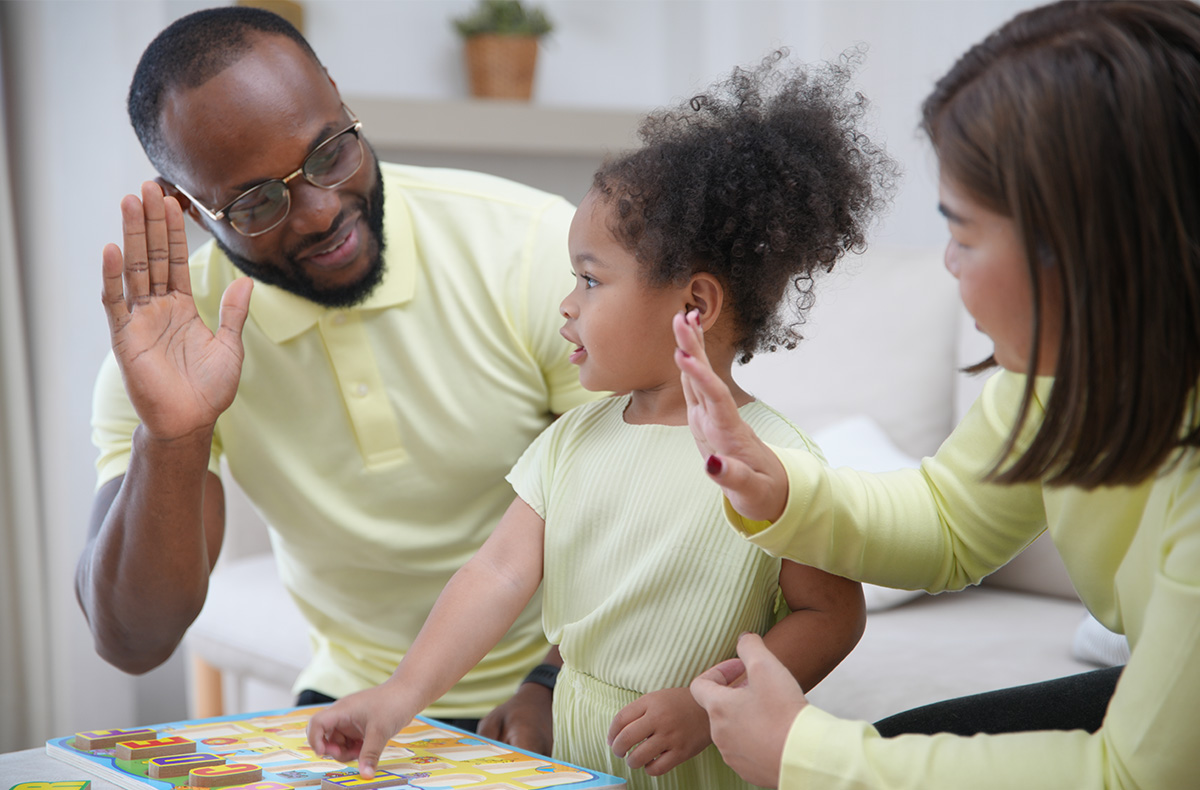Few things can stress parents out like the belief, however fleeting, that their child is falling behind in some crucial stage of development and is therefore doomed to a life of anguish. Even before they are born, children are inspected, examined, and compared to their millions of peers in an effort to discover and head off any potential issues. Children are poked and prodded at birth, then the examinations move past just the physical into new realms – psychological, social, cognitive, and of course language.
Language is a special one because unlike quarterly pediatrician visits or occasional meetings with a child’s preschool teachers, parents are observing and interpreting a child’s linguistic progress every day. While growing another pound heavier or a half inch taller passes unperceived, a child’s first sounds, words, and sentences are celebrated as they happen.
These milestones tend to follow a general pattern, which is a blessing and a curse for parents. The blessing is that these guides can alert parents and caregivers to potential issues. The curse of course is that even a slight difference or “delay” in a child’s linguistic path can have parents panicking, perhaps projecting their anxieties onto the child and complicating things even further.
Parents, educators, and caregivers need to understand that linguistic development will be a distinct journey for every child. Not one person on earth has ever learned to speak and read exactly how another person has, so applying strict schedules to a child’s advancement is defeating the purpose. Everyone wants the best for their children, and so the best way to interpret these stages of language development is as general guidelines of milestones to look forward to and encourage, not as a sort of ticking-clock deadline each child must meet.
In this guide, we will outline the general stages of language development for children and include some best practices for parents, caregivers, and educators.
3-6 Months
Newborns tend to sleep a lot, and just as first-time parents are starting to think “Wow, this parenting thing isn’t nearly as hard as people say,” babies “wake up” around three months and start to express themselves, generally through crying. This is known as the pre-linguistic stage, and their cries are their first way of communicating and telling you they need something. It is your job to figure out what.
There is a lot going on for babies, and though it may seem like they are only focused on eating, sleeping, and crying, they are actually constantly studying and learning about their new world and environment. Slowly but surely, this observation will become interaction. This usually first occurs in the form of eye contact, then a smile or laugh. Around 6 months, this interaction generally becomes a bit more vocal, as babies start experimenting with producing their own sounds, and you’ll get something like the classic “goo-goo-gah-gah.”
At this stage, exposure to language is important, both in the form of “baby talk” that children can start to understand, as well as hearing advanced conversations that expose them to the plethora of sounds that exist in language. The most important thing to do at this stage (and really every stage) is simply to interact with children, put them in language-rich environments, and allow the natural learning process to do its thing, however long it may seem to take.
6-12 Months
The sounds and vocalizations are increasing now, and most infants are elated to discover they can use their mouths and vocal cords as a new “toy.” They will start experimenting with all sorts of different sounds, clicking, smacking their lips, blowing raspberries, screaming, making whispering noises, etc. This is known as the babbling stage, and infants can get quite creative with the strange sounds they produce, sometimes even startling parents with weird squeaks or growls.
Babies are starting to realize that all the sounds grownups are making with their mouths hold some major significance, and that they too are capable of using this tool. They just haven’t quite figured out how to do it yet. At around 9 months, babies may start pointing, shaking their heads, and gesturing. This is a new power for babies, and they may become quite demanding and insistent with it.
At this stage, infants may start to understand important words like “bye-bye” and “milk.” They may recognize their names, but not exactly understand that it’s referring to them. They are getting better at understanding tones, like “No!” if they’re doing something potentially dangerous.
Parents can help children at this stage by reading to them, and parents are often surprised to find that babies will become quite engrossed in the books and reading process well before they understand any of the words. This early exposure to language and literacy is an important tool parents can use throughout the language acquisition process.
Maybe, just maybe, around 12 months children might have said their first word, but that is not an ironclad rule of potential cause for concern.
12- 18 Months
By 18 months, most children have spoken their first word or more, but even 18 months is a loose guideline. The general pattern for children is that they will learn nouns (ball, doggy, tummy), then verbs (eat, sleep, play), and finally adjectives (little, yummy, bad). This period is known as the holophrastic stage and involves communicating with one word.
They may start to understand the concept of questions and responses, and start asking one-word questions themselves – “Cake?” In terms of comprehension, toddlers at this stage can likely understand simple instructions like “Give me your hand” or “Shhh.” Complying with those instructions may be another matter entirely.
Parents and caregivers need to encourage and reinforce each word a child learns as much as possible. If your daughter says “ball,” for example, repeat the word, and make a game of having her say “ball” for you to hand her a ball. You then take it away, she says “ball” again, and you give it back to her.
18-24 Months
This is generally when children experience what is called the “language explosion,” and their vocabularies expand from the bare basics to over a hundred meaningful words. There is a rapid increase in both output and comprehension at this time. Children are sponges at this stage, taking in everything and seeing how they can apply it to their own language.
Some children may enter the famous “Why?” stage, where they question absolutely everything. This may be exasperating for parents and it is more than likely the children don’t understand (or even really care about) the answers, but it is an important way for children to use the power of their words to obtain more information.
At this stage, you can gently correct mispronunciations by repeating or restating whatever they said in the correct form. This should always be done in a fun way, and little mistakes should be seen as cute rather than cause for concern.
Age 2-3
This period is generally part of the telegraphic stage and it is where the building blocks for multi-word sentences are first formed. One of the most common ways to create a multi-word sentence is by simply adding “no” or “don’t,” and children will likely start using this to express their dislikes, often quite loudly.
At this stage, they may start to correctly use words for more abstract concepts like “want” and “understand.” Some other common words during this stage are more pronouns (we, she, her), as well as location words (under, over, next to). Children may also begin to accurately add the “-ing” suffix to action verbs, and perhaps experiment with “-ly” adverbs like “slowly” or “quickly.”
Children can often follow more advanced conversations now and will increasingly enjoy story time and books. Parents can pour on the content at this stage, but it’s better to do it through meaningful interactions than screen time.
Age 3-4
This is the age of trial and error, and errors will run rampant, but likely be endearing rather than troubling. Children will adventure out into more complicated structures but still stumble with irregular nouns and verbs. It is common for children to say things like “foots” instead of “feet” and “go-ed to the park” instead of “went to the park,” but these are actually positive indicators. The child is employing standard English grammar by adding -s to the end of plurals and -ed to past tense verbs, but sometimes English just doesn’t work like that.
It is important to encourage output at this stage no matter what. When your son makes a small mistake by saying something like “I drink-ed juice,” you can gently correct him by replying “You drank juice? That’s great!”
Another good activity for this age is to take turns naming different things in different categories, such as animals, vegetables, etc. Children will enjoy the game aspect of it, while categorization and classification will help them build their vocabularies and start to recognize linguistic similarities and differences.
Age 4-5
Children at this stage should be motoring right along with their speaking and listening, and starting to progress into letter recognition and pre-reading. When communicating, they will start to acquire more advanced forms of interaction, such as taking turns speaking, describing emotions, telling detailed stories, talking about their dreams, etc.
This stage is a good opportunity to let kids get a little silly and have fun with language. You can make up stories and ask them for input on different details, like “What color shoes is the monster wearing?” and then tailor the story to those details to keep the child engaged. When reading, place your finger under each word so kids can get used to tracking the words and start to match them to different sounds. There are lots of engaging educational websites and programs for kids, but choose wisely and try to ensure that screen time is always a supplement to learning.


